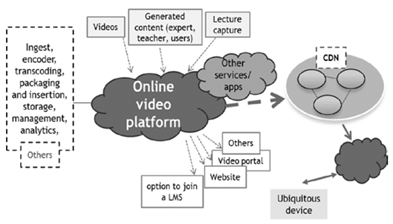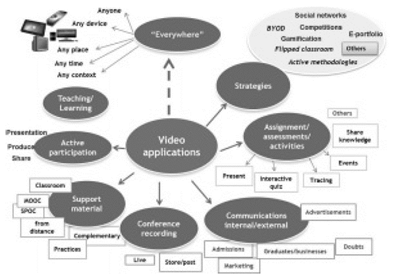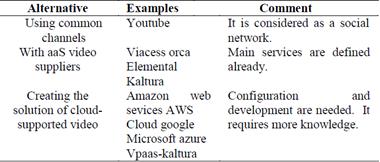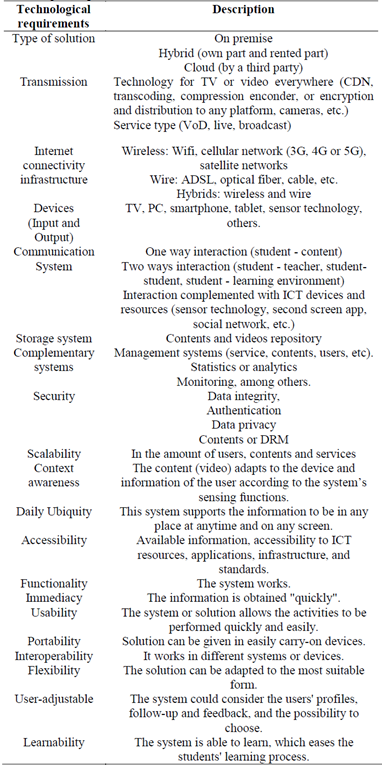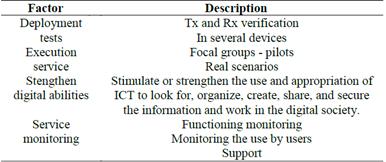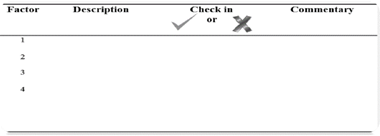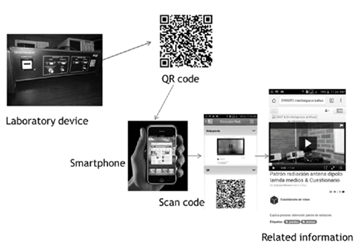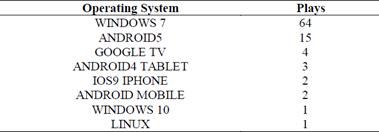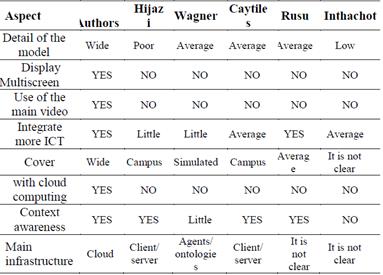1. Introduction
Although ICT have significantly contributed to education by supporting the teaching-learning process, some challenges remain and here are still several aspects to improve in the educational field such as: formal education during working life, lifelong learning, greater access to education for all, availability, connectivity, interaction, flexibility, mobility, overcoming space-time barriers, access to distance learning resources, awareness of ICT use, significant contents, relevance, innovation, effectiveness, [1-6], as well as inequity and inclusion [7], and greater appropriation for educational use [8]. Also, there is the challenge for teachers to understand the context of young people (known as digital natives or millennials) [9], because they could seem distracted by electronic devices and bored in a traditional class. Thus, the teachers should use different strategies, adapt new technologies and even acquire and apply digital abilities to be able to motivate their students.
U-learning and video platforms everywhere can contribute to overcome these challenges. U-learning is one of the application fields of ubiquitous computing, whose founder was Mark Weiser [10]. He laid out that computing would be everywhere, in a transparent and invisible way to the user. Ubiquitous learning or u-learning is defined as the learning that can be obtained by using any device, at any time and place, and is embedded in everybody’s daily life [11-13]. U-learning covers other ICT models for education such as computer based training-CBT, e-learning, m-learning, and t-learning, by using different ICT resources.
This article proposes a model of u-learning based on platforms of Multi-screen TV (uLMTV), which allow to display video on different screens under connectivity contexts, making possible to widen its application field in education while continuing projecting the reflection about u-learning. Trends in digital technology, convergence, and cloud computing, among others, are taken into account. In this paper, multi-screen TV is also related to television everywhere (TVE), where TVE refers to video and/or TV contents that can be seen “everywhere”, on different screens (multiscreen), supported by Internet.
The rest of the article is organized as follows. Chapter II offers a review of the literature. In chapter III, the method is explained. In chapter IV, the results are shown, in which we present a proposal based on video platform everywhere, the uses of video as main content, implementation alternatives, the detailed uLMTV model and an experimentation scenario. In chapter V, the discussion is presented. Finally, the conclusions are presented.
2. Materials
2.1. U-learning models
Another definition of u-learning is the ecosystem where any person wishes to learn actively about any area of knowledge; which can be accessed from any place at any time, keeping contact with any other person by using any ICT resource and ubiquitous device [14]. Immediacy, accessibility, interactivity, context awareness, flexibility, scalability, security, daily ubiquity, portability, functionality, user-adjustability, interoperability, learnability, usability, and interconnectivity can be counted as features of u-learning [15-21].
In the literature, we found several proposals of u-learning models, most of which use mobile devices, in some cases, together with sensory technology. But we find little detail of the models or clarity for its actual implementation. They overlook the possibility of displaying content on any screen; or the use of video as a key element that could strengthen the learning process even more. Hijazi and Itmasi [22] propose a Crawler Based Context Aware Model for Distributed e-Courses through Ubiquitous Computing, in which they use PC and mobiles within a university campus. In Rabello et al [23] a Collaborative Multi-agent Model is shown for Decentralized Ubiquitous Education Environments, applied in a simulation with mobiles and for this, agents must be installed. A model for profile management [24] uses semantics in a simulation scenario. Joo and Park [25] propose a U-SM model (Ubiquitous Scaffolding and Mentoring) which applies online advising online and the necessary support for students who have just started their learning process, based on computers distributed around the campus and on a LMS platform. Nevertheless, technological aspects and other trends are not mentioned, and its context is limited. Caytiles [20] presents a model of a ubiquitous learning environment based on mobile devices and wireless sensor networks. Díaz and Rusu [9] propose a methodological model of computer-supported collaborative learning based on collaboration and communication tools, in order to define activities and spaces of work, but they do not mention how it would be technologically supported. In [26] it is shown an instructional model of u-learning using the project-based learning approach to improve students’ abilities of creation-innovation; it only sets out the use of PC and mobiles, though.
2.2. Video or TV everywhere
TV has evolved [27]; first it was the over-the-air broadcasting, then the transmission of several channels over cable, satellite, and also over telecom networks. Later, in the 90´s, there was the third generation of TV, with the platforms of digital TV and the beginning of massive implementation of digital terrestrial television, which led to optimize the electromagnetic spectrum, and to have a better quality of image and sound. Towards mid-2000s, along with the adoption of the Internet broadband, the increase of the transmission speeds, the download of video content and online streaming have taken rise. Video and TV online continue growing [28], becoming the fourth generation of TV, based on online transmission of connectivity to broadband Internet. In these new scenarios of TV, as Noam [27] mentions, new elements appear, such as resolution (4K and 8K), person-to-computer interactivity, 3-D, peer-interactivity, computer-enhanced reality, user-generated content, peer-to-peer content, asynchronous viewing and individualization, multi-platform distribution, branching plotlines, user participation, and globalization. Putting these and other elements together makes possible to have a high-resolution, immersive, participatory, customized, social, TV of wider experience.
As it is indicated by Sanz and Crosbie [29], we go from closed TV platforms (traditional service) to open TV platforms by using Internet or hybrid platforms that can give more value to the company and to the user. The understanding and connection with the users is one of the main benefits of the distribution in digital platforms that imply bidirectional connectivity [30].
Some examples of this route of convergence are the TV connected to Internet (with smart TVs or through computers, video game consoles, set top box, blue ray readers, etc.) and the HbbTV standard [31] as hybrid between TV Broadcast and Broadband promoted in Europe. Different TV suppliers are implementing hybrid solutions [32] like broadcast + IPTV (ex: DVB-T+IPTV), or broadcast + OTT, or IPTV + OTT, or migrating to offer their services via Internet (known as OTT), and migrating towards multiplatform strategies for distribution of content [30]. That is why TVE appears, technically known as multi-channel programming distributors (MVPDs), which cable operators began to use as Comcast to offer an online aggregation of television programming [28].
Television can then be seen not only on a TV set but on multi-screen TV services [33], in which users can see the videos on different screens (e.g. smartphones, game consoles, tablets, PCs, and TVs). The fast adoption of mobile and portable devices as smartphones and tablets, known as second screens, transforms the traditional form of watching TV.
Video leads traffic growth in Internet [34], and many online video platforms (OVP) prevail in the market, such as vimeo, telestream, among others. Thanks to ubiquitous devices, broadband growth, wireless technologies, digital convergence, OTT services, cloud computing, CDN, among other advances, users can enjoy content in any place at any time.
2.3. Over The Top (OTT)
OTT is the delivery of video, audio, TV, and other services via Internet directly to the user's connected devices [35] (Fig. 1). Some examples of OTT services are Youtube, Whatsapp, Netflix, HBO go, Twitter, Hulu, Skype and other apps. TV suppliers [36] constantly look to offer OTT services to their customers; for instance, UNEPLAY and Caracolplay, in Colombia; Directvplay, in Latin America; Xfinity, in the United States; Tving, in South Korea; and iPlayer of the BBC, in England.
2.4. Cloud computing
According to The Information Technology Laboratory (ITL) at the National Institute of Standards and Technology (NIST) [37], cloud computing is a model for enabling ubiquitous, convenient, on-demand network access to a shared pool of configurable computing resources (e.g., networks, servers, storage, applications, and services) that can be rapidly provisioned and released with minimal management effort or service provider interaction.
This cloud model promotes availability and is composed of five essential characteristics: On-demand self-service, Broad network access, Resource pooling, Rapid elasticity, and Measured service [37]. In addition, the cloud computing model considers three service models (Cloud Software as a Service (SaaS), Cloud Platform as a Service (PaaS), Cloud
Infrastructure as a Service (IaaS)); and four deployment models (Private cloud, Community cloud, Public cloud, Hybrid cloud).
Other characteristics of cloud computing are manageability, scalability, availability, economical, on-demand service, expedient, ubiquitous, multitenant, elasticity, and stability. The user can select the resource as required (hard disk, operating system, networking, access control, among others), benefiting from “pay as you go” (PAYG) model, in which users pay for what they use [38].
2.5. Content Delivery Network (CDN)
A CDN is a system of software, hardware and network components that acts like a great distributed computer [39]. This system allows to copy the contents or objects in different servers located in different geographic areas to optimize delivery performance and to be experienced by users [40]. Fig. 2 illustrates the elements of CDN such as servers and points of presence (POP). Examples of CDN suppliers are Akamai and limelight.
2.6. Encoders and transcoding technologies
MPEG-H/H.265 suite [41,42], -which is focused on the delivery of media in heterogeneous environments, IP networks and digital broadcasting networks- includes HEVC compression format (high efficiency video coding), which is more efficient in mobile applications and supports hi-res 4k/8k, 3D TV. It also includes the MMT standard (The MPEG Media Transport) that defines the Encapsulation, Delivery, and Signaling, as well as the application layer forward error correction (AL-FEC), among others. Transcoding is defined as converting one compressed input bitstream to an outgoing bitstream [43]; that is to say, it can change from one format to another to adapt the content according to the device. Widely used technology ABR (adaptive bitrate) encodes a video at multiple bitrates and maximizes the video bitrate within the available bandwidth. This allows to deliver a higher fidelity video over HTTP when possible, and dropping to lower quality rather than causing an interruption of playback of the excessively high bitrate video [44].
3. Methods
In order to obtain the model proposal, research was led by using exploration, reviewing and interpretation of the theory available in the academic community. Description and innovation were also used, and the contribution of technological trends solutions was considered. The methodology is based on the design- based research (DBR) [45], and at agile methodology [46] thanks to the cyclical character in design. Among the instruments used, we can find literature review, documentation and experimentation.
Five stages were defined: 1) Review of the theoretical framework and tendencies in u-learning, cloud computing, OTT, CDN, among others. 2) Analysis to identify key aspects and basic requirements as well as identification of implementation options. 3) Definition of the model, components and key aspects. 4) U-learning prototype for deployment in several screens. 5) Model validation by means of an experimental case and tests. This paper will mainly focus on the model and an experimental case will be set out as an example for the prototype and validation.
4. Results
4.1. Video everywhere platform
Those platforms must be able to adapt contents (like video) into any format and device. This platform must have the necessary technologies of encoding, transcoding, gateway or middleware, as well as storage option, management, encapsulation and distribution technologies, among others. The ideal is for it to be “cloud” supported”, due to its characteristics and advantages. Video platform(s) can be complemented with other services of cloud computing (e.g. Google apps or G suite). The Fig. 3 illustrates the scenario.
Fig. 4 lays out different uses of the video, such as to be used in the classroom or online at any time, recording conferences, documenting cases, sharing knowledge, performing competitions, interactive quizzes, external communications with alumni, in social networks, among others.
4.2. Implementation alternatives in video everywhere platforms or multi-screen TV
The implementation of a u-learning service based on video everywhere platforms can be: a) on-premises, having all the necessary infrastructure of hardware, networks and software; b) hybrid, having certain own infrastructure and other services in the cloud with a third party; and c) cloud supported, in which infrastructure is supported by another company. The Table 1 indicates implementation examples.
The platform to be implemented or chosen must consider the codification, trans-codification, transport and display to different devices, storage, and CDN options, among others.
4.3. uLMTV model
uLMTV Model (ubiquitous learning based on platforms of multi-screen TV) is defined as an ecosystem made up of multiple items that contribute -to a certain degree- to the u-learning solution. It looks like the solar system, where all elements are somehow linked to each other. It considers several levels, each one of them including a group of specific factors. There is a feedback loop (between the levels and the intra-level) to redefine or project the improvements of the ubiquitous learning service. The Fig. 5 illustrates the model:
First level - Initiation: They are related to the first steps, the u-learning idea, the actors that can take part, technology trends, and other necessary steps. See Table 2.
Third level - Production/implementation: once the requirements are defined, we proceed to the learning environment and service construction, among others. It is also necessary to know if it counts on a part of the infrastructure or on all of it, or if it will be outsourced. See Table 8.
Fourth level - u-learning service implementation: it includes the evidence of the display, the implementation or execution of the service, the strengthening and development of digital abilities, and the service monitoring. See Table 9.
Fifth level - learning result: it must be the main aspect: how the teaching/learning process was favored and what the obtained impact of the u-learning service is. See Table 10.
4.3.1. Checklist
To define what aspects or elements will be considered in each level, we propose to check with a ✓if it is carried out or with an X if it is not, and to have another field to be filled in with comments, as it is shown in Fig. 6.
4.4. Experimental case
As a proof of concept, and to exemplify the u-learning service based on platforms of multi-screen TV, a scenario with several complementing videos for the internship in the area of telecommunication has been set up. The video was embedded in the cloud supported with video platform kaltura, and its link is published via e-mail or WhatsApp.
We defined aspects such as educational context, formal education, u-learning role (complementary), topics on optical fiber connection in the academic subject of optical communication, and obtaining pattern radiation in the subject radio-propagation and antennas; content (video), an interactive feedback quiz, additional interaction by means of QR code, video platform used (kaltura). Tests are carried out with several ubiquitous devices such as smartphones, TV, PC and Tablets, connected to Internet through wireless networks (wifi, cellular), and wire net. See Fig. 7.
Fig. 8 illustrates a case using sensor technology (QR codes, and the camera of a Smartphone) in a laboratory device.
92 video views were performed in four platforms (PC, Tablet, Smartphone, and in TV connected with google TV), Table 11. 90 out of 92 views were seen in Colombia and two in the United States, confirming coverage in any place.
Views were seen in 8 different operating systems (Table 12).
The 92 reproductions were seen in 10 different Web browsers as chrome, chrome mobile, firefox, IES, safari4, and mobile safari.
5. Discussion
The model shown is an example to perform a u-learning service based on platforms of multi-screen TV, where more than one device can be used to interact with the content. The video is considered as an important element to be implemented in different activities of the teaching/learning process. Video platforms that best fit the needs and conditions of teachers and institutions must be identified. For this test, it was defined to use video platform kaltura, which besides offering a free version, allows to add an interactive quiz application to the video, favoring a different experience when watching the video. In addition, this video platform is a cloud-supported service, which favors the u-learning characteristics.
It is possible to use several video platforms or other cloud support services/applications to complement the activities within the teaching/ learning process; for example, youtube channels. These allow students to create their own videos, or to share and record an e-portfolio by means of a blog.
Some of the elements laid out in the model were positively experienced, like the sense of ubiquity, interoperability, functionality, portability, and context awareness (the video was adapted in different test devices, and using sensor technology with QR codes). A longer curve of time takes place at the beginning of the learning process, especially about the technological aspects while the u-learning environment and services are developed and configured. A wider implementation of u-learning will require to consider many more elements, as well as the resources and efforts needed to carry it out. It is here where creativity, innovation and free resources (mainly for education) are needed.
The tests of the video deployment worked properly in the various devices and operating systems used. The interaction with QR code arranged in a laboratory device worked correctly too (which allows accessing the video that illustrated the process of practice) by using a mobile device, confirming the versatility of the cloud supported video platform we used. Among the navigators, the most frequently used was Chrome. The video had an application layer with an interactive quiz, which gives another impression to engage the user more, and provides feedback. In certain PC or Tablet equipments, in google TV, and in cellphones with IOS, the content of the interactive quiz could not be viewed because of certain aspects such as an old navigator version or the lack of some complements. This can be avoided in future versions by finding other options or second-screen applications.
The idea within the u-learning approach is to use diverse ICT resources and platforms that allow the content/applications to be “everywhere”, to enrich the learning process, and to take the experience beyond the classroom, and to provide more flexibility, among others. As Lopez et al. emphasize [47], this u-learning ecosystem is supported by the convergence of technologies, telecommunications, internet connectivity scenarios, and computing systems, in which video content can be adapted to any screen.
When comparing the model and the topic presented in this paper to several mentioned authors (see Table 13), some aspects stand out such as: multiscreen display, more information of the elements of the model, the video as main content, and the use of cutting-edge technology as cloud computing, CDN services, and TV everywhere.
The Table 14 and Fig. 9 illustrate that the model based on TV everywhere or multi-screen video platforms supported in the cloud includes advantages as opposed to traditional TV/video systems like digital terrestrial television (DTT), Digital satellite television (DST), digital cable television (DCT) and IPTV private server, which use only one means or device or specific standard, or requires to have an infrastructure. Table 14 illustrates that the cloud-supported video platform optimizes the deployment to different screens, and supports more operating systems and navigators.
In Fig. 9, it is shown that the solution of cloud supported TV/video is of faster implementation, greater coverage and can support more interactivity than other traditional platforms.
6. Conclusions
The u-learning model based on platforms of multi-screen TV takes into account various elements that, when being considered partially or totally, contribute to the learning everywhere. The video is presented as the main content, which can be applied in different activities or strategies to favor other experiences and have a better impact in the learning. Due to the advance of digital technology and convergence, it is possible for the video to be displayed in different screens. Any user or traditional TV supplier can implement a hybrid or complete solution based on online cloud-supported video platforms. Results demonstrate a satisfactory and optimal deployment of the video in multiple screens, and the model as a good example since technology trends like OTT, CDN, and adaptive bitrate are taken into account as well as the cloud-supported video.
Although the proposed model is based on connectivity scenarios, u-learning also considers to continue learning “off-line” (with analogous elements, books, etc.). At the same time, the infrastructure topic (connectivity to Internet) becomes a challenge for the institutions or companies to provide the users with the benefit of being connected to the network. In u-learning, any device or ICT resource can favor and enrich the teaching and learning process beyond a traditional classroom, showing different application choices. The large use of mobile devices and their advantages of portability and mobility allow to extend the scenarios thanks to second screen applications and the use of sensor technology like QR codes. Cloud computing services favor to extend and implement real scenarios of u-learning in contexts of formal, non-formal and informal education, and in other contexts as well. The role of u-learning as complement, partial or alternative, can be implemented. U-learning favors personal learning environments (PLE) by making possible for the student to choose among different options. As future work, we expect to continue validating and giving feedback on the model, as well as working on the prototypes and u-learning service implementations that consider more elements from the outlined uLMTV. We will consider standards like LOM (Learning Object Metadata), analytics, articulation with LMS, more interactivity options and context awareness, customization, evaluation. We will also verify the significant learning, among others.















